WHEN IN ROME, DO AS THE ROMANS DO
(NOT THE BRITISH)
With Puccini’s Tosca, Lyric Opera has done one update too many this season. Don Giovanni was bumped up 300+ years in time to the 1920s, Capriccio 100+ years also to the 1920s, and Il Trovatore was transposed forward 400+ years to the 19th century. Only Anna Bolena with its incredibly well-known Tudor setting and Porgy and Bess with its rather more contemporary setting were allowed to stand. In contrast, British director John Caird’s Tosca doesn’t seem to know when its historical moment is.
For those who don’t know, Caird, who began directing for the Royal Shakespeare Company in the 1970s, co-directed with Trevor Nunn both Nicholas Nickleby (the 9-hour version in 1980) and Les Misérables (playing at a theater near you since 1985). Although not new to the world of opera, he has been concentrating on this form for the past few years, including 2013’s Parsifal at the Lyric.
Based on Victorien Sardou’s 1887 play La Tosca, Puccini’s operatic version premiered in 1900. The action unwinds during the Napoleonic wars, as Rome is caught between the competing armies of France and Naples. It’s a very specific historical moment that is lost in this Lyric and Houston Grand Opera co-production. Although there is a love story at the heart of Tosca between the painter Mario Cavaradossi and the singer Floria Tosca, the plot is set in motion by the politics of the time. Without that, the romance loses its mooring and it’s impossible to make sense of why Cavaradossi risks his life to save the former consul and escaped prisoner Count Angelotti. A setting in 1870 or during World War II, when Rome was similarly besieged (as in 1800), could work, but not some ill-conceived late-19th/turn-of-the-century setting. British set and costume designer Bunny Christie notes influences from 1880s Venice as well as World War II Europe.
Tosca begins in a church, develops in a palace, and ends in a fortress. Each of these settings, however, are actual places: Sant’Andrea del Valle, the Palazzo Farnese, and Castel Sant’Angelo. In Christie’s hands, these magnificent settings become ugly, bombed-out buildings. While the church is serviceable, one is left wondering why the interior’s only painting goes on the ceiling, as opposed to the walls, let alone why the painting’s fragments are spread out over each level of the multi-story scaffolding. More interesting is the opera’s Act Two setting, which is full of plundered antiquities and resembles more a warehouse than a palace.
In addition to the opera’s original setting, John Caird modifies and adds to Luigi Illica and Giuseppe Giacosa’s libretto. One unnecessary such change is the manner of Tosca’s death. Instead of simply throwing herself off the castle’s ramparts, Caird has Tosca plunge a knife into her neck before falling. It makes the scene bloodier and postpones her death, but accomplishes nothing further.
A more intriguing change is the expanded role of the shepherd. Originally written for a boy as a few lines sung at the beginning of Act Three, the shepherd becomes in Caird’s hands a girl who appears at pivotal moments in all three acts. Each time she is closely associated with Tosca, highlighting the singer’s own pastoral childhood, as related in Sardou’s play though absent from the opera. Unfortunately, Christie’s bizarre costuming obscures rather than illumines the shepherd’s character and function by dressing her like a girl about to make her first communion.
It is not just the big things that Caird and Christie get wrong, but also the details of Act One’s liturgical procession and Act Three’s executions. Caird has the cardinal (who correctly arrives last) preceded by two priests carrying thuribles. First, there should only have been one thurible, and it should have been carried by an acolyte (or thurifer). Second, the priests shouldn’t have been wearing crosses, which are typically worn only by bishops. Third, when the cardinal kneeled, he should have taken off his mitre at the same time as he handed over his crozier. Act Three begins with one prisoner hoisted up and hanging from the hole in the roof. Yet, if there’s a hole in the roof, what is the rope attached to? Caird then leaves the prisoner perversely hanging throughout the entire act. Hangings are meant to be accomplished quickly, by means of a snapped neck rather than a slow suffocation.
By contrast, Puccini’s opera moves rather swiftly and compactly, without a single wasted moment or prolix line. There’s not even an overture to set the stage. Instead, there is an abundance of dramatic orchestration, especially for brass, as well as welcome Wagnerian leitmotifs.
Tosca’s arias might be short and sparse, but they contain some of the composer’s most gorgeous and memorable music. As the titular lead, Russian soprano Tatiana Serjan gives a stirring performance of “Vissi d’arte” in Act Two that, though lacking in subtlety, contains precocious amounts of power and passion. American tenor Brian Jagde, playing Tosca’s lover Cavaradossi, sings rather more sweetly in his swan song “E lucevan le stelle.” Together they make a rather believable and well-matched couple. Russian baritone Evgeny Nikitin’s Baron Scarpia menaces the two lovers in a rather restrained, not terribly threatening or frightening manner. It is easy to conclude that, once again, Lyric has attracted excellent singers, but not cast them particularly well. Perhaps replacement leads Hui He, Jorge de León, and Mark Delavan will fare better during the second half of Tosca’s run (Feb. 27-Mar. 14).
If you can look past the flawed visions of Caird and Christie, Tosca remains an enjoyable production, not least because of Puccini’s haunting score, energetically conducted by Dmitri Jurowski in his Lyric debut. Chicago Children’s Choir make welcome appearances in Act One, brightening the otherwise dark and gloomy set. Richard Ollarsaba of the Ryan Opera Center similarly shines in the brief but important role of Angelotti. His clear and limpid bass-baritone has already been heard in three Lyric productions this season, and remains to be heard in one more, Weinberg’s The Passenger. Stay tuned for Wagner’s Tannhäuser, beginning February 9.
Tosca
Lyric Opera of Chicago
Civic Opera House, 20 N. Wacker Drive
scheduled to end on March 14, 2015
for tickets, call 312.827.5600
or visit Lyric Opera
for more info shows, visit Theatre in Chicago

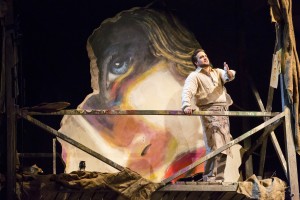
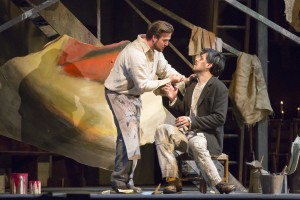
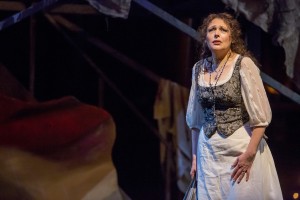
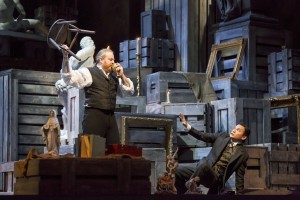
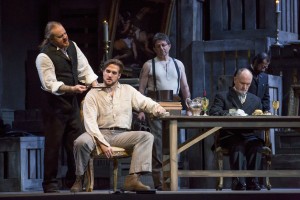
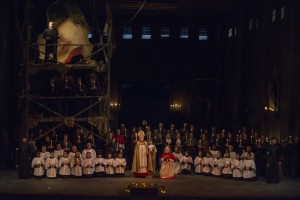
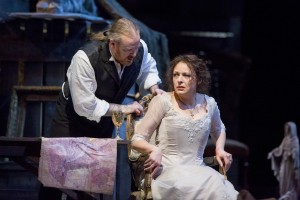
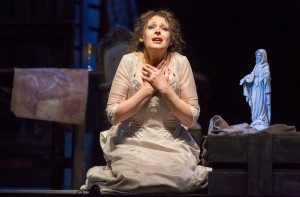
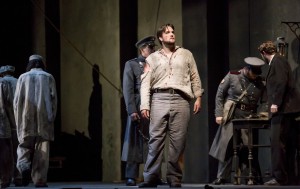
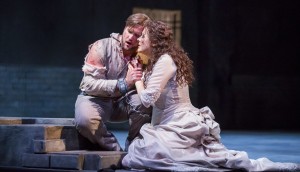
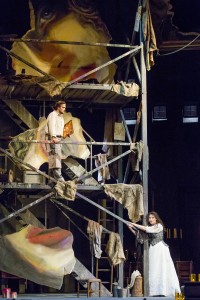
{ 2 comments… read them below or add one }
I wrote the Lyric on Sunday after witnessing the fiasco of the settings for Tosca. While I tried to reconcile the “store room office” setting for the second act by rationalizing that a corrupt chief of police might possibly use his office for ill-gotten art pieces, no way could I find any means to accept the third act setting.Puccini stated the specific location and this variation was incomprehensible. There was no sense of height whatsoever. Distressing performance, mainly to the sets. Voices are most important, but there are other things that enhance the opera experience. This performance lacked too many of these “other things” to be successful.
One other side note…Tosca could have reached over a tad further (even if it was not in the original direction) to seek a lighted candle to place next to Scarpia’s hand rather than place a DEAD candle as was done Saturday night. This is critical, but I hope constructive so we do not witness such travesties again at the Lyric.
I’ve been to 4 or 5 operas but I’m a “musical theater person” and have been to a hundred and performed in 30 to 40 myself.
The singing was beautiful.
The sets were interesting and creative.
The costumes were lovely.
But there was something greatly lacking in the direction and the “movement” of the show. It lacked “believability”. And I’ve seen more honest emotion in inexpensive community theater productions.
Sorry… just being honest.